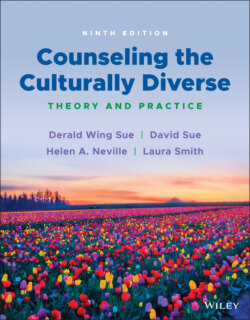Читать книгу Counseling the Culturally Diverse - Laura Smith L. - Страница 11
EFFICIENT UP‐TO‐DATE COVERAGE
ОглавлениеWe maintain our two‐part division of the book, with 11 separate chapters in Section 1: The Multiple Dimensions of Multicultural Counseling and Therapy, and 13 population‐specific chapters in Section 2: Multicultural Counseling and Specific Populations. We introduce Section 2 by providing a chapter, “Culturally Competent Assessment” (Chapter 11), that ends Section 1 and transitions to Section 2. This transition chapter outlines the many variables that influence assessment, diagnosis, and case conceptualization—which guide the reader's understanding of each specific population to follow. All have been thoroughly updated using common topical headings (when possible) that allow better cross‐comparisons between and among the groups. Readers familiar with the eighth edition will note the incorporation of new information on transgender communities within the LGBTQ chapter. We have also combined several chapters to form a new one on Religious Communities.
We have heard from some textbook adopters that the breadth and depth of coverage of CCD has made it very difficult for instructors and students to digest the amount of material in a single course. This is a very legitimate concern but we would like to make several points.
First, although there may be differences of opinion, we have identified the first 11 chapters in Section 1 as providing the basic principles of cultural competence that can be applied across multicultural populations. These are foundational building blocks of multicultural counseling and therapy, which we believe all practitioners must acquire in order to move toward cultural competency. In our classes, for example, the first eleven chapters are mandatory for a semester course.
Second, although it would be ideal if all of Section 2, with the 13 specific populations could be covered, we never expected that all these chapters could be digested in a single course. Rather, we envisioned instructors selecting Section Two chapters that they felt were important for students to master. Some may choose to focus on racial/ethnic populations, others on sexual orientation and gender identity, others on poverty and disability, or any combination of special populations. Other instructors have used the special population chapters to allow students with interest in a particular group to do class presentations and term papers. Section 2 allows considerable flexibility and has unique appeal to professors and students.
Third, to aid in making the material less overwhelming, we have condensed, summarized, streamlined, and eliminated certain subtopics. In one case, two chapters were combined. We have tried our best to do so without violating the integrity of the content. Each of the major chapters (1 through 11) has been shortened but the special population chapters have maintained their original length. This latter decision was based on our belief that further shortening would result in the chapters having a “checklist” quality. Further, we are also aware that most instructors do not assign all special population chapters, but rather choose the ones most relevant to their classes.
Despite shortening major sections of the text, new advances and important changes in multicultural counseling suggest additional areas that need to be addressed. These include updating concepts to be consistent with Diagnostic and Statistical Manual of Mental Disorders (DSM‐5) categories and principles, the multicultural guidelines of the American Psychological Association, the American Counseling Association's (ACA) multicultural and social justice competencies, and Council for Accreditation of Counseling & Related Educational Programs (CACREP) standards.
We also include the most recent research and theoretical formulations that introduce and analyze emerging important multicultural topics. These include the concept of “cultural humility” as a domain of cultural competence; the important roles of White allies in the struggle for equal rights; the emerging call for social justice counseling; the important concept of “minority stress” and its implications in work with marginalized populations; a new focus on microinterventions; reviewing and introducing the most recent research on lesbian, gay, bisexual, transgender, and queer (LGBTQ) issues; major research developments in the manifestation, dynamics, and impact of microaggressions; and many others.
